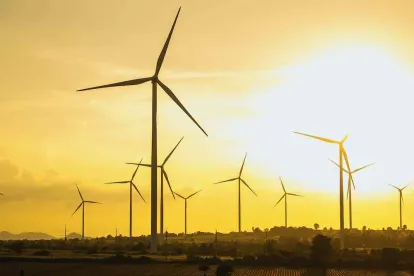The rise of offshore wind
Offshore wind technology is becoming increasingly mainstream. In 2009, offshore wind represented only 1% of global wind generation capacity, a figure which had grown to 10% by 2019.1 In recent times, the rise of the ESG movement and the ever increasing regional and global pressure to transition to a sustainable future, as reflected in the United Nations 2030 Agenda for Sustainable Development and the United Nations Paris Agreement on Climate Change, has increased the heat on the oil majors to join the energy transition. A number of the oil majors have seized on offshore wind as an opportunity to invest in ready-to-build assets at significant scale, allowing the oil majors to demonstrate high levels of capital expenditure on climate-friendly projects. Despite being slightly late to the game, a number of the oil majors now view offshore wind as an element of their own transition from international oil companies to international energy companies.
Muscling in
The move into offshore wind by certain oil majors has given rise to concerns that a potential bubble is developing. Further, some of the more traditional players in the offshore space may be out-priced and/or crowded out as a result, with Ørsted, for example, unable to acquire any development interests in the UK’s Fourth Licensing Round despite being a long-standing participant in the sector. The ripples created by the new entrants may also drive out the more financially conservative investors such as pension or infrastructure funds.
Easing the pressure on return margins
The subsidy regimes for offshore wind have generally been successful in developing the commercial viability of the sector. For instance, in the UK, the allocation of Renewable Obligation Certificates and more recently the Contracts for Difference through the Low Carbon Contracts Company, has contributed to increasing the proportion of the UK’s generating capacity coming from offshore wind, as well as demonstrably lowering the cost of power. The UK’s most recent Contract for Difference (CfD) auction resulted in record low prices – £39.65/MWh and £41.61MWh for the two first phases of the Dogger Bank project, for example. Given that the market price reference price in the auction was £52/MWh, these projects may be considered to be delivered on a subsidy free basis.2 Long-term offtake arrangements have also resulted in a business that is attractive for its stable, long-term contracted returns.
The level of returns associated with offshore wind projects has therefore reached a relatively mature and steady state in the UK. Participants in the sector could theoretically bid higher prices in the CfD auctions in order to safeguard higher returns but such a move is likely to impact on the competitiveness of their bid. Accordingly, this prompts questions regarding to what extent is the premium that oil majors are paying or prepared to pay to invest in these projects sustainable? One way may be for the oil majors to draw on their engineering, technical and operational experience to achieve certain development, construction and operational efficiencies in and around an offshore wind project to improve the return margins associated with an offshore wind investment.
For example, oil majors are adept engineering and operational businesses and, as such, are used to being able to apply their technological capability to significantly improve efficiencies and productivity. Although the nature of the technology in offshore wind provides less scope for the operational performance improvements that oil majors customarily generate, there still remains some scope for improvements which the oil majors are well placed to capitalise on. For example, oil majors have historically invested in technology to improve their drilling prowess that has enabled them to extract significant amounts of additional barrels of oil. However, equivalent investments in offshore wind turbines is not likely, at this stage, to generate similarly significant additional wind power. That said, oil majors may draw on their technological capability to improve the quality and performance of the supply chain and project management processes, including multi-contracting interface matters.
Another area where oil majors could improve the return margins associated with an offshore wind investment is to contribute to improvements in grid technology and infrastructure. For example, it has long been recognised that a “north sea grid” (first proposed in November 2008) would bring about significant economic benefits including the ability to integrate a larger amount of renewable energy into the grid (thereby enabling participants to contribute to meeting climate/carbon reduction targets), ensure security of supply and create an internal energy market. It is also key to developing integrated, hybrid offshore projects. However, there are significant challenges associated with this – limited experience on the technical side, regulators and other stakeholders need to work out support structures for offshore generation to transmission connection regimes - which makes the challenge multifaceted and progress slow. This may be seen with the Kriegers Flak (Denmark and Germany) and Cobracable (Netherlands and Denmark) projects. Oil majors with their strong balance sheets, technological clout and influential policy and industry voice are well-placed to propose solutions to these challenges and accelerate multi-stakeholder efforts in this space.
Oil majors could also look to offshore hydrolysis to produce green hydrogen. Offshore wind generates electricity that can be converted to hydrogen via the electrolysis of seawater and transported via existing gas pipelines. Transporting these hydrogen gas molecules is much cheaper than transporting electrons via heavy electricity cables from wind farms on the North Sea to land. For instance, the Neptune Energy Q13a oil and gas platform is anticipated to produce green hydrogen from sustainable electricity that is generated by the sun and wind. If this platform is successful, it would demonstrate how the majors could capitalise on their oil and gas experience in the North Sea to contribute to achieving efficiencies in the transportation of energy as well as the broader energy transition.
Proprietary data management and trading expertise have long provided oil majors and their shareholders with great returns. In sophisticated power markets such as the UK, the access to large amounts of electrons gives the trading arms of oil majors the ability to generate significant revenue. As offtake arrangements for offshore wind projects increasingly contain a merchant element, trading in the power generated by offshore wind projects will also become increasingly viable. Battery storage will facilitate this by enabling power to be stored and traded at the desired time. The business case for this would be strengthened by green hydrogen as it lends itself more easily to being stored.
The oil majors may be able to move up the learning curve more quickly than other new entrants in the offshore wind space, and there is real potential for efficiencies to be made during the construction and operation in and around an offshore wind project as a result of the engineering, technical and operational experience of oil majors. However, it is too early to say today to what extent such meaningful efficiencies will be achieved and to quantify the impact it will have on return margins.
First blast of the trumpet
In the end, success for the oil majors in the low carbon space will likely come from a diversification of clean technologies, particularly those which can be bolted onto and enhance their existing strengths (e.g. hydrogen), and a diversification of geographies, notably those outside the UK and Europe.
Frontier risk management is another area of capability that the oil majors may bring to bear in the global offshore wind sector. There are (and certainly will be) an ever increasing number of less developed markets which are keen to leap frog their electricity generation capacity straight into utility scale renewables such as offshore wind. This again potentially plays well to the development skill set of the oil majors, as they are likely to already be well versed in navigating the local governance and regulatory framework and, as such, providing them with first mover advantage.
As such the future news story will likely not all be about wind, however nor will this merely be a puff of air – for what has been seen in the offshore wind sector is really an early blast of the trumpet. With the improving oil price, deep pockets and a greater alignment with their investor base, the oil majors will likely become a significant player in the energy transition - they are very much on the march.
__________________________________________________________________
1. “Global Offshore Wind Report 2020”, Global Wind Energy Council, accessed here https://gwec.net/global-offshore-wind-report-2020/>
2. J Guillet, “The lazy and incorrect use of the word ‘subsidy’”, Green Giraffe, 4 December 2020, accessed here https://green-giraffe.eu/blog/lazy-and-incorrect-use-word-subsidy>






 />i
/>i
